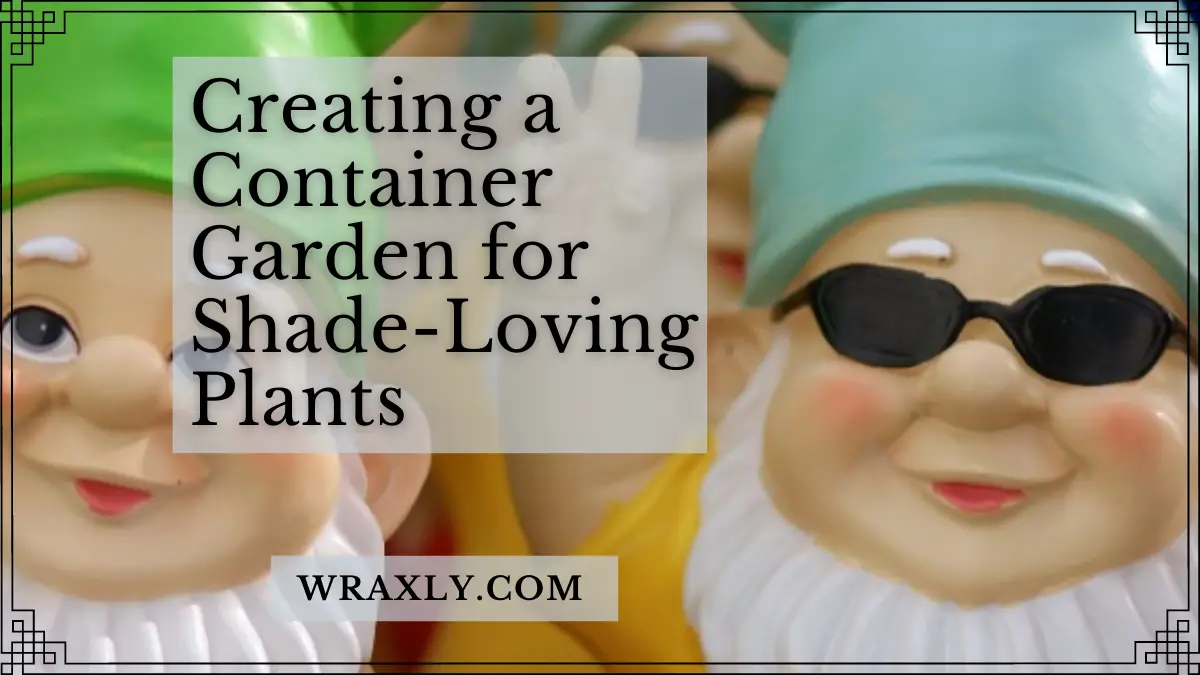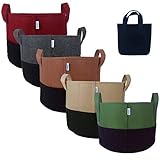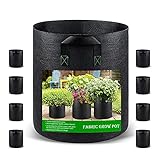If you’re looking for a way to add some color and life to your yard, but don’t have a lot of sun, consider creating a container garden for shade loving plants. There are many beautiful plants that thrive in shady conditions, so you can create a lush and colorful garden even if you don’t have much sun. By using pots or containers, you can easily move the plants around to find the best spot for them. And if you get tired of one arrangement, you can switch it up anytime you want. So if you’re ready to try your hand at gardening, but don’t have a lot of sun, read on to learn everything you need to know to create a container garden for shade-loving plants!

- Understand the Different Types of Shade Settings
- Select Shade Loving Plants for Containers
- Add Some Non-Plant Garden Elements
- Choose the Best Containers for Your Full Shade Garden
- Don’t Forget to Provide Water
- Beware of Excess Moisture
- Full Shade Gardening FAQs
- Final Thoughts on Creating a Container Garden for Shade-Loving Plants
Understand the Different Types of Shade Settings
The first step in creating a container garden in the shade is to understand the type of shade that is present in your growing location. Generally, there are three common types of shade conditions:
- Partial Shade: Areas that receive between three and six hours of light per day.
- Filtered Light: Areas that receive dappled light, such as a forest understory.
- Full Shade: Areas that receive less than three hours of light per day.
Knowing the difference between those three types of shade is crucial as some plants will grow well in one shade setting but struggle in another. Once you identify the type of shade that you have in your container garden location, you are ready to begin selecting plants.
Select Shade Loving Plants for Containers
Now that you know the difference between the multiple types of shade conditions, you’re more prepared to find plants that will do well in your shade garden. The next few sections will introduce you to some shade-loving plants in three distinct categories.
Shade Loving Flowering Annual Plants
Annual plants last for a single season, and there are many flowering annuals that do well in shade gardens. Here are a few of the most popular annual plants that you can grow in containers in shade settings:
- Begonia
- Coleus
- Fuchsia
- Impatiens
- Lobelia
- New Guinea Impatiens
- Sweet Potato Vine
Shade Loving Flowering Perennial Plants
Unlike annual plants, perennials will return year after year if they grow in the correct conditions. Here are a few lovely perennial plants that grow in the shade:
- Astilbe
- Bleeding Heart
- Coral Bells
- Ferns
- Hosta
- Lily of the Valley
- Pulmonaria

7 Shrubs that Grow in Shade
Plenty of woody plants can survive in varying degrees of shade. However, many larger shrubs will quickly become too large for containers. Below are a few shade-tolerant shrubs that are small enough to live in containers for at least part of their lifespan:
- Anise
- Boxwood
- Daphne
- Hydrangea
- Tree Peony
- Mountain Laurel
- Virginia Sweetspire
Focus on Foliage Plants
When selecting plants for a shade container garden, we suggest focusing on species that offer ornamental value via their foliage. While some flowering plants will tolerate shade, many of the most popular flowering species require more sunlight. By contrast, there are many plants with captivating leaves that love to live in lower light conditions.
Focusing on foliage plants makes it more likely that you’ll achieve your desired result with your shade container garden. Also, the textures and color patterns that attractive leaves provide can be surprisingly captivating. You might surprise yourself with how beautiful of a garden you can create while relying on interesting foliage alone.
FURTHER READING
- Variegated Wax Plant Care: Everything You Need to Know
- How to Plant Elephant Ear Bulbs in Pots
- Water Lily vs. Lotus: What’s the Difference?
Add Some Non-Plant Garden Elements
While the previous sections prove that many visually pleasing shade plants exist, your plant options for shade areas are relatively limited. However, that does not mean that your shade garden must lack intrigue. Fortunately, there are numerous interesting garden elements that you can include to make a shade garden more appealing. Here are a few examples for you to consider:
- Boulders
- Water features
- Arbors
- Hardscape paths
- Seating areas
It’s rare for the elements above to amount to an attractive garden design on their own. However, if you include them in your plan, you’ll find that they can complement your main planting ideas.
Choose the Best Containers for Your Full Shade Garden
The quality of your containers is crucial regardless of the light conditions in which your garden grows. The best garden containers proved ample space into which your plant’s roots can expand. They also allow for excellent drainage to prevent the soil from becoming waterlogged.
You’ll find many garden container options online and in your local garden supply center. But not all of those containers are equally effective. For example, fabric grow bags often stand out from other choices for their advantageous material quality. Unlike clay, plastic, and stone garden containers, fabric grow bags are entirely permeable, allowing for better air circulation and drainage.
This is critical for plants grown in shady spots.
The size of the container should also be taken into account when planting in a shady spot. A large container can accommodate several small plants, while a smaller one will require just one or two plants. Be sure to select plants that thrive in the same light conditions.
Recommended Fabric Grow Bags
| Image | Title | Prime | Buy |
|---|---|---|---|
 | 6-Pack 5 Gallon Plant Grow Bags, Premium Aeration Nonwoven Cloth Fabric Grow Bags with Sturdy Handle and Shrink String | PrimeEligible | Check Price on Amazon |
Top | Wraxly Fabric Grow Bags - 5 Gallon Colorful Two-Tone Felt Planter Pots. Premium Heavy-Duty. [5-Pack of Assorted Colors - Plus Black Bonus Bag!] | PrimeEligible | Check Price on Amazon |
 | OPULENT SYSTEMS 5-Pack 5 Gallon Grow Bags Heavy Duty (Black) … | PrimeEligible | Check Price on Amazon |
 | VIVOSUN 5-Pack 5 Gallon Grow Bags Heavy Duty 300G with Handles | PrimeEligible | Check Price on Amazon |
 | Tall Grow Bags, 5 Gallon 8 Pack Grow Pots with Handles, Improved 280G Deep Plant Growing Bags, Classic Black | PrimeEligible | Check Price on Amazon |
 | iPower 5-Pack 5 Gallon Plant Grow Bags, Tan | PrimeEligible | Check Price on Amazon |
 | VIVOSUN 5 Pack 5 Gallon Square Grow Bags | PrimeEligible | Check Price on Amazon |
Don’t Forget to Provide Water
A lack of moisture sounds like a problem that should be exclusive to gardens that grow in full sunlight. However, that is not the case. Consider that many shade locations are shady because there are trees or structures directly above them. Those overhead elements can essentially act as an umbrella that impedes rainfall from reaching your garden below.
Monitoring soil moisture is critical no matter where your garden grows. If your container garden sits under some form of cover, be sure to monitor the soil moisture often. You may find that the soil is surprisingly dry despite not receiving a significant amount of sun exposure.
In fact, shady spots can be up to 20 degrees cooler than other areas of the garden, so it’s important to keep an eye on soil moisture levels.

Beware of Excess Moisture
While a lack of moisture can become a problem for your shade garden, the opposite issue is more prevalent. The lack of sunlight in shade gardens makes it much easier for moisture to accumulate on your plants and in the soil.
Excessive amounts of moisture can be detrimental as they can give rise to certain fungal and bacterial infections in your plants. The best remedy here is to avoid overwatering your plants. Soaking your plants and their soil by default can quickly lead to your plant’s downfall.
Even when you supply the correct quantity of water, moisture problems may persist in shade locations. As such, a gardener who tends a shade-loving garden needs to remain vigilant and recognize when mold, fungus, and bacteria have begun to afflict their plants. The sooner you notice such unwanted occurrences, the sooner you can find an effective treatment.
Your best course of action is to take preventative measures against these diseases by ensuring that your plants have proper drainage. If you’re growing your plants in containers, make sure that they have drainage holes at the bottom. It’s also a good idea to raise your containers up off the ground using pot elevators. This will help to keep the soil in your containers moist, while also allowing air to circulate around the plants.
Full Shade Gardening FAQs
Growing plants in shady locations can be a difficult task, which is why many people have questions about the process. Below we’ve provided a few answers to the most common of those inquiries.
Many gardeners believe that a shade garden is destined to be a dreary and colorless scene. However, there are several ways that you can brighten the appearance of your shade garden. The most reliable way to do this is to add plants with attractive foliage textures and colors to your garden. There are also a few shade-loving plants that produce colorful blooms that can brighten the shady areas of your yard.
Plants cannot survive in a complete lack of sunlight. Even shade-loving plants require at least a little sun exposure each day. After all, the definition of full shade settings indicates that those areas are not entirely shaded for the duration of the day. With that said, there are plenty of plant species that can grow with minimal light exposure. At times, these plants live on just one to two hours of light each day.
Many vegetables prefer to grow in full or partial sunlight. However, some vegetables are much more shade tolerant. Here are a few popular examples that you can grow in your shade garden:
— Arugula
— Beets
— Bok choy
— Broccoli
— Cauliflower
— Kale
— Turnips
Growing a successful shade garden requires you to select plants suitable for low-light settings. However, even if you are judicious in your plant selection, there’s a chance that some of your plants may continue to struggle with a lack of sunlight. If that’s the case, you’ll need to recognize the signs that your plants aren’t getting enough sun. Here are some signs to watch out for:
— Leaf discoloration
— Lack of flowers
— Lack of new growth
— Weak growth habit
If you notice those issues in your shade garden plants, it’s wisest to move them to a sunnier growing location. One of the main conveniences of using containers is that you can move your plants whenever you like. Rather than digging your plants out of the ground, you can shift them to an ideal location with minimal effort.
Preparing soil for a shade garden is a lot like preparing the soil for any other garden. For example, you’ll want to add soil amendments that improve the soil structure and nutrient content. Improving soil nutrients can be especially important for shade gardens that grow beneath large trees. The roots from those trees likely absorb most soil nutrients before your smaller plants can. However, gardening in containers eliminates that issue.
Final Thoughts on Creating a Container Garden for Shade-Loving Plants
Growing a container garden in shady conditions comes with some limitations. But if you know what kind of shade is present on your site and the plants that will grow in those conditions, you are off to an excellent start. So if you’re looking to add some life to a shady spot in your garden, follow the guidance we’ve shared above. With a little bit of effort, you can create a beautiful and lush full shade garden that will thrive all season long – regardless of how much sun it gets. Happy gardening!

John Haryasz is a freelance writer and landscape designer. In the field of landscape architecture, he has contributed to many successful design projects throughout the country. As a writer, John specializes in creating captivating and informative web content. Through that work, he aims to share his design knowledge and promote engagement with the outdoor world.

![How to Water Indoor Plants [Plant Care 101]](https://wraxly.com/wp-content/uploads/2021/03/How-to-Water-Indoor-Plants-Plant-Care-101-1200-1024x576.webp)

![Growing Plants from Cuttings [A Simple Guide]](https://wraxly.com/wp-content/uploads/2021/03/Growing-Plants-from-Cuttings-A-Simple-Guide-1200-1024x576.webp)